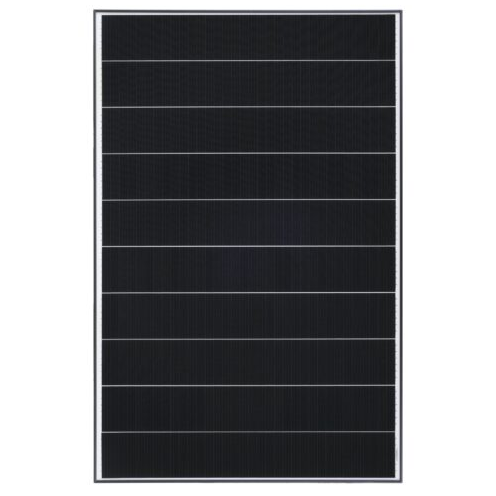Shingled solar panel components are made by slicing traditional battery cells (single crystal, polycrystalline, Sunpower, etc.) and connecting each small piece in a forward and backward stacking manner. The layout method is usually horizontal or vertical (but Sunpower components are also patented in vertical arrangement, and companies generally use horizontal arrangement). Finally, special conductive adhesive is used to connect them in series/parallel, and then laminated packaging is carried out.

lingtech shingled solar module 420W
Different from the traditional solar panel, the traditional solar panel welding is to weld the positive and negative poles of the solar panel through copper strips, and the gap between the panels should be 2-4mm (depending on the size of the panel). And the shingled solar panel components do not have these, so under the same area, the power of shingled solar panels will be greater than traditional solar panels, and natural power generation will be more. Alternatively, under the same power, the area of shingled solar panels will be smaller than that of traditional solar panels, but the area receiving direct sunlight will not be smaller.
What is shingled solar technology?
Shingled solar refers to the use of laser slicing technology to cut the entire battery into several small battery strips, and use conductive adhesive to flexibly connect the layers of the battery strips. This operation can optimize the component structure, achieve zero spacing between battery cells, and place 5% more battery cells in the same version compared to other types of components, effectively improving the module’s light receiving area.
The latest generation of efficient tile stacking technology adopts battery surface optimization technology, improving the ability to collect current and further increasing the energy density limit of component packaging
High density photovoltaic modules packaged using shingled solar technology have five unique product advantages, allowing shingled solar modules to have stronger “vitality” than traditional modules.
1、 Higher conversion efficiency
Due to limitations in the welding process of traditional components, there is usually a 2mm gap between battery cells, resulting in a large amount of blank area in the components. In the shingled solar module, the distance between the battery cells and the stack of the battery cells is 0, which can encapsulate more battery cells in the same area, thereby improving the conversion efficiency of the photovoltaic module.
Traditional battery cell welding vs. shingled solar cell welding
2、 Stronger resistance to hot spots
The “hot spot effect” of photovoltaic modules is one of the most important factors affecting the power generation of the module. When the “hot spot effect” reaches a certain level, continuous local heating and high temperature can burn the module, causing glass fragmentation, battery cell charring, and back plate burning through. Even if the components are not burned out, hot spots can directly shorten the service life of photovoltaic modules by 30%, which in the long run will cause photovoltaic module failure.
3、 Lower risk of cracking
The components using shingled technology are flexibly connected to the battery cells through conductive adhesive, with uniform stress distribution. This not only adapts to thinner silicon wafers, but also reduces the risk of cracking.
Traditional components may experience hidden cracks during use, with the maximum possible length of the hidden cracks extending to the entire length of the battery cell (half of the length), while stacked components may extend up to 1/6 of the entire length of the battery cell (determined by the number of slices). The laminated tile component can effectively limit the impact of hidden cracks to a smaller area, and even if hidden cracks occur, the power loss of the component will be less
4、 Less occlusion impact
The shielding of the photovoltaic power station will not only reduce the power generation efficiency of the module, but also may lead to the generation of hot spots, bringing hidden dangers to the safety of the power station. Compared to ordinary photovoltaic modules, the impact of occlusion on shingled solar modules is much smaller.
When the component is installed vertically, the bottom string is blocked, and the power attenuation of the conventional half piece component is 50%, while the power attenuation of the conventional whole piece component is 100%. And the power attenuation of the stacked tile component is only 33% when a single row of batteries fails; When the component is horizontally installed, it blocks the bottom string, and the power of conventional whole and half piece components decreases by 33%, while the power of shingled solar components only decreases by 17% due to single row battery failure.